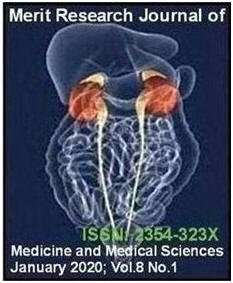
|
|
|
|
|
 |
/ / MRJMMS Home / / About MRJMMS / / Submit Manuscripts / / Call For Articles / / Editorial Board / / Archive / / Author's Guide / /
|
Other viewing option
Search Pubmed for articles by:
Alhaj
AM
|
Prevalence of Urinary Tract Infection among Children attending Khartoum State Hospitals |
|||
|
Afraa M. Alhaj1* and Magdi Bayoumi2 |
||||
|
1M.Sc,
Microbiology Department, Faculty of Medical Laboratory Sciences,
University of Medical Sciences and Technology (UMST), Khartoum,
Sudan Received December 06, 2019; Accepted December 14, 2019, Published January 28, 2020 |
||||
|
Abstract |
||||
|
Urinary tract
infection is the most common serious bacterial infection causing
illness in infants and children; it accounted for 10% of all
febrile illnesses in children. It is more common in preterm
babies (4-25%) than term ones (1%). In early life, it is more
common in males than females then decline rapidly in the
prepubertal life girls experienced more episodes of UTIs than
males, 8% compared to 20% respectively. The prevalence rates of
UTI varied by age, gender, race, and circumcision status.
Uncircumcised male infants less than 3 months of age and females
less than 12 months of age had the highest baseline prevalence
of UTI. This study conducted to determine prevalence of Urinary
Tract Infection among Children attending Khartoum State
hospitals. Cross-sectional prevalence study of 200 samples of
mid-stream urine was collected from children attending three
hospitals in Khartoum state. A demographic questionnaire were
collected and urine samples were tested microbiologically by
standard procedures. Kirby-Bauer technique was performed for
testing commonly used antimicrobial agents by measuring
susceptibility of the isolated organisms according to NCCLS
guidelines. The growth of clinical isolates ≥104 CFU/ml of urine
samples represent significant bacteriuria was representing 58
(29%), for insignificant growth 19 (9.5%) and 123 (61.5%) no
bacterial growth. Among children age (2-16 years) presenting
with sign and symptoms of UTI, the overall prevalence in females
33.6% [38/113] and among males 23% [20/87]; while 17 circumcised
male and 3 uncircumcised male had UTI. The most common
uropathogens isolated were Escherichia coli (44.8%),
Staphylococcus aureus and Klebsiella Spp (20.7%) for each and
Enterococcus facials (6.9%). The susceptibility to antimicrobial
was high for impenem (96.56%), amikacin (94.8%), gentamycin and
nitrofurontoin (75.8% & 74.1%) respectively but low for
cefotaxime 29.31%, ceftazidime (24.13%), Amoxyclave and
tetracycline (13.8%) each. A high prevalence rate of UTI among
children shows a notable correlation between microbiology findings
and clinically-suspected UTI in some Khartoum state district
hospitals. Circumcision among boy tend to decrease the incidence
of UTI, the rate of UTI in uncircumcised boys are more prone to
UTI. The antibiotics commonly used in UTIs are less effective by
55.17% e.g.: ciprofloxacin. Since the present study was a
short-time study, regular monitoring is required to establish
reliable information about resistance pattern of urinary
pathogens among children for optimal empirical therapy. |
Merit Research Journals© 2021 || Advertisement | Privacy policy.
